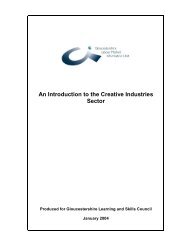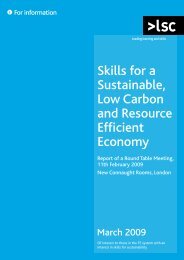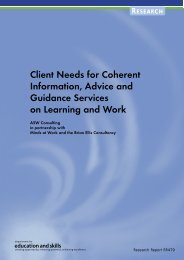Mapping the Big Green Challenge - The Skills & Learning ...
Mapping the Big Green Challenge - The Skills & Learning ...
Mapping the Big Green Challenge - The Skills & Learning ...
Create successful ePaper yourself
Turn your PDF publications into a flip-book with our unique Google optimized e-Paper software.
<strong>Mapping</strong> <strong>the</strong> <strong>Big</strong> <strong>Green</strong> <strong>Challenge</strong> 149thought not to be interested in earnest green rhetoric (and as such were ‘hard to reach’) but couldbe engaged by competition and prizes. <strong>The</strong> proposal included <strong>the</strong> measurement of <strong>the</strong> footprint of agroup of friends, tailored email advice on reductions, measurement at <strong>the</strong> end of <strong>the</strong> period and areward for <strong>the</strong> group making <strong>the</strong> greatest reduction. It is <strong>the</strong> way this proposal builds on existingnetwork relationships that makes it a strong example of <strong>the</strong> use of this 3 rd sector capability anddistinct from those proposing to set up a website with advice on very similar matters but with noclear strategy of how to engage an audience for <strong>the</strong>ir message.8.3 Increasing <strong>the</strong> Visibility of Personal BehaviourA Community Commitment to Low Carbon Living8.3.1 Distinctive Innovative CapabilityIf one makes a decision to do something about behaviour which is primarily in <strong>the</strong> private sphere<strong>the</strong>n, however much one intends to keep it, it is easy for that resolve to slip without anyone holdingyou to account. In contrast being a member of a 3 rd sector group that is formed on <strong>the</strong> basis of ashared commitment or set of values means <strong>the</strong>re is a ‘public’ context where that pledge can be heldto account. Thus, in contrast to <strong>the</strong> community action described in 8.1 above, this is an approachthat is strongly directed at maintaining behaviour. In broader terms it can be seen as <strong>the</strong>underpinning of both religious (and o<strong>the</strong>r ‘intentional’) communities that agree to live <strong>the</strong>ir lives inline with certain principles and practices and of, say, alcoholics anonymous where members meettoge<strong>the</strong>r to reinforce each o<strong>the</strong>rs’ commitment.In contrast to <strong>the</strong> previous two capabilities, this is not built on a community already in existence as aresult of location or interest. Instead it is a new association based on strong ties deriving fromshared norms or values. Public campaigns have attempted to use this approach by getting people tosign up to pledges. However <strong>the</strong> advantage <strong>the</strong> 3 rd sector group has here is that <strong>the</strong> commitment istied in to specific personal relationships and <strong>the</strong>re is scrutiny over members’ adherence to <strong>the</strong>commitment that <strong>the</strong>y have made. In this and o<strong>the</strong>r ways <strong>the</strong> 3 rd sector group is likely to be able togive a stronger sense of being part of some collective commitment. <strong>The</strong>y may also be able to engagenovel forms of ‘rewards’ (and possibly punishments) to sustain this commitment.8.3.2 Contribution to Low Carbon GoalsAs <strong>the</strong> literature on changing behaviours reviewed in Chapter 2 made clear, one of <strong>the</strong> problemsthat needs to be addressed is habitual behaviour. Much of what we do is not consciously thoughtthrough on each occasion but ra<strong>the</strong>r follows embedded practices. <strong>The</strong> significance of this is thateven when people fully intend to change <strong>the</strong>ir behaviour it is very easy for <strong>the</strong>m to fail to do this inpractice or to lapse back into earlier habits after a short period. This problem is exacerbated inrelation to low carbon goals because much of <strong>the</strong> habitual behaviour being targeted (e.g. leavingequipment on standby) is located within <strong>the</strong> home and thus not subject to wider scrutiny. Publiccampaigns have tried in general ways to raise <strong>the</strong> profile of <strong>the</strong>se issues and make <strong>the</strong>m more salient(by, for example, stressing <strong>the</strong> financial savings to be made). <strong>The</strong>re are also technical devices, suchas meters showing real time energy use, which try to make <strong>the</strong> financial consequence of <strong>the</strong> decisionto leave on, or switch off, equipment more visible on an on-going basis. In addition, businesses, andindeed community groups, have been encouraged to make public commitments to address suchissues in <strong>the</strong>ir own practice.Appleby Ltd July 2009











